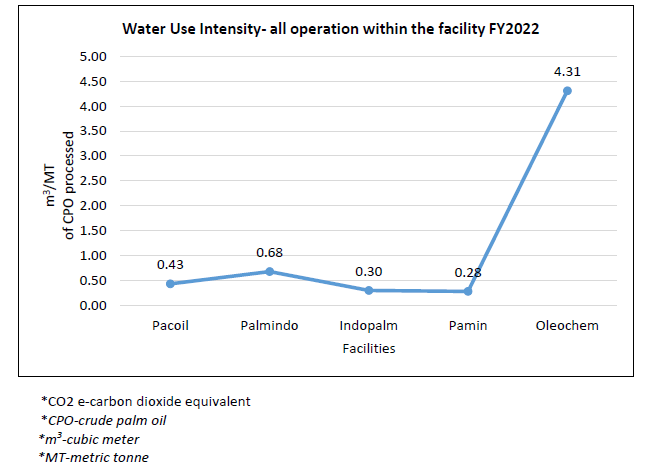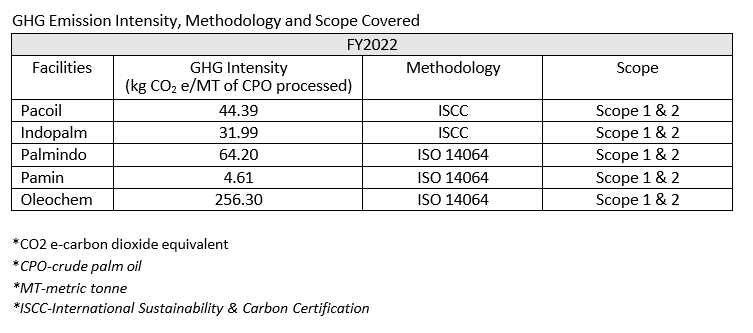WATER MANAGEMENT
Water is a shared resource; therefore, optimising its consumption is crucial. PIL Group collects data to track our consumption patterns. In 2022, our water consumption for refineries and oleochem was 5.71 m3/MT of CPO processed compared to 5.03 m3/MT of CPO processed in 2021. Over the two years, water use intensity increased by 0.68 m3/MT and we plan to improve water-use intensity wherever applicable.
The commitment of our refineries and oleochem to reduce water use intensity by 2030 from a baseline of 2022 are as follows; Pacoil and Indopalm to reduce 0.03 m3/MT of CPO processed, Palmindo to reduce 0.07 m3/MT of CPO processed, Pamin to reduce 0.02 m3/MT of CPO processed and oleochem to reduce 0.11 m3/MT of CPO processed.

CARBON MANAGEMENT
PIL Group is aware that increasing carbon emissions have adversely impacted the environment and climate. We are committed to reduce our carbon footprint gradually by implementing best management practises and monitoring our emission intensity. The key operations at our refineries that contributes to GHG emission are refining, fractionation, wastewater treatment, electricity, chemical, and fuel consumption.
Our refineries and oleochemical are committed to reduce GHG emission for both scope 1 and 2 by 2030 from 2022 baseline as follows:
Ø Pacoil to reduce GHG by 5% from a baseline of 44.39 CO2 e/MT of CPO processed
Ø Indopalm to reduce GHG by 4% from a baseline of 31.99 CO2 e/MT of CPO processed
Ø Palmindo to reduce GHG by 5% from a baseline of 64.31 CO2 e/MT of CPO processed
Ø Pamin to reduce GHG by 4% from a baseline of 4.61 CO2 e/MT of CPO processed
Ø Oleochem to reduce GHG by 5% from a baseline of 256.30 CO2 e/MT of CPO processed
The GHG emission at Pacoil measures 44.39 CO2 e/MT of CPO processed in 2022 and 43.03 CO2 e/MT CPO processed in 2021. Indopalm recorded 31.99 CO2 e/MT of CPO processed in 2022 and 23.00 CO2 e/MT of CPO processed in 2021. The increase is due to increased volume of CPO processing and we aim to gradually reduce our carbon footprint. The emission intensity reported for Pacoil and Indopalm covers scope 1 & 2 of emission intensity. Our other facilities - Palmindo, Pamin and oleochem have commenced to monitor their respective GHG emission intensity from 2022 onwards and we will be able to report their progress in coming years.





